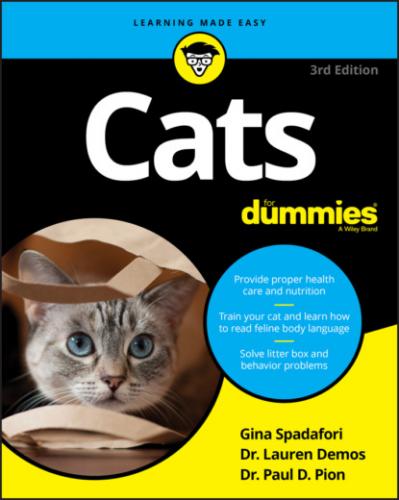The temperament of longhaired cats depends on what’s underneath that lovely coat. If an Oriental body is underneath — such as in the Balinese — you’ve got an active cat. The larger, more thickset body types, such as those of the Persian and Norwegian Forest Cat, tend more toward the laid-back end of the spectrum.
The big cats
Although you’ll never see a pet cat as big as a St. Bernard — or at least, we certainly hope not — a few breeds definitely warrant the heavyweight category where cats are concerned. Although most healthy cats — pedigreed or not — weigh between 8 and 12 pounds, some of the big cat breeds range between 15 and 20 pounds, especially the males. Now that’s a cat who can keep your lap warm on a winter night!
The biggest domestic cat is thought to be the Siberian cat, with some males topping 20 pounds. This breed is pretty rare, however, so if you’re looking for maximum cat, you may want to consider the Maine Coon or maybe the Norwegian Forest, another longhaired chunk of a cat. Other longhaired cats with an above-average size include the Ragdoll, Turkish Van, and American Bobtail (see Figure 2-5).
For a lot of cat without the fur, consider the British Shorthair, the American Shorthair, and the Chartreux.
© John Wiley & Sons, Inc.
FIGURE 2-5: The Turkish Van, Maine Coon, and British Shorthair are perfect breeds for those who like their cats large.
Something different
New cat breeds are created all the time, some by accident, some by design. Many cat breeds start after someone notices a kitten with something “different” — ears, legs, or other characteristics that set him or her apart from other cats. These cats, shown in Figure 2-6, are some of the rarest around and among the most controversial. They’re also among the most expensive to acquire — if you can find one at all.
© John Wiley & Sons, Inc.
FIGURE 2-6: The short-legged Munchkin, short-tailed Japanese bobtail, ear-altered Scottish fold, and nearly hairless Sphynx are all certain to start a conversation.
Coat — or lack of it — sets some breeds apart. Primary among these breeds is the Sphynx, a cat who’s nearly hairless — nothing more than a little fuzz on his face, feet, and tail. The Rex breeds — Cornish, Devon, German, and Selkirk — all sport kinky hair, as does the LaPerm and the American Wirehair.
Some breeders of Rexes claim an additional distinction for their breeds: They claim that the cats are hypoallergenic. Some people with allergies may be able to tolerate certain breeds more than others, true, but unfortunately, no such thing as a completely allergy-proof cat exists.
Tails — or lack thereof — are the talk in other breeds. The Manx is undoubtedly the best-known tailless or short-tailed cat, but others are on this list, too. The Cymric is a longhaired Manx; the Japanese Bobtail, American Bobtail, and Pixie-Bob round out the ranks of the tail-challenged.
And what about ears? Two breeds are based on an ear mutation: the Scottish Fold, with ears that fold forward, and the American Curl, with ears that arch backward.
Undoubtedly the most talked-about new breed has been the Munchkin, a cat with short legs. Although some people say that the breed is a mutation that shouldn’t be developed into an actual breed, others see little difference between having a short-legged cat breed and a short-legged dog breed, of which several exist. One thing is certain: The controversy over breeds developed from mutations isn’t about to abate anytime soon.
Should you consider any of these breeds? Of course. If you’re looking for something that’s sure to start a conversation whenever company comes over, these cats are just the ticket. But be prepared, too, to hear from those who think it’s a bad idea to perpetuate such genetic surprises.
The unCATegorizables
What did we tell you earlier? Herding cats is hard work, and some breeds refuse any efforts at being categorized. One, the Singapura, a Southeast Asian breed that resembles an Abyssinian, is noteworthy for being exceptionally small, which practically puts the breed in a category of its own.
And where do you put the Snowshoe, a cat with many breeds in its background who resembles a white-mitted Siamese but isn’t as active? We couldn’t decide.
Three other breeds are of medium size and temperament but are notable for their coats. Count among these the Korat and Russian Blue, from Thailand and Russia, respectively, both remarkable for their stunning blue-gray coats — as is the Nebelung.
The Not-So-Ordinary Everyday Cat
Most people couldn’t care less if a cat has a pedigree or a fancy breed name — they just like cats and are content to adopt one that strikes their fancy or wanders into their lives. Calling a nonpedigreed cat a “mixed breed” isn’t exactly right, however, because most breeders are so careful with their pedigreed cats that the possibility of an unplanned breeding is almost nil. The everyday cat, shown in Figure 2-7, really is completely random-bred, produced as a matter of complete serendipity with no rhyme or reason at all — at least not where humans are concerned! We like the British name for these cats — moggies.
© John Wiley & Sons, Inc.
FIGURE 2-7: The tuxedo, calico, and the most common pattern — the tabby — reflect the variety found among random-bred cats.
Still, randomness being what it is — random —
